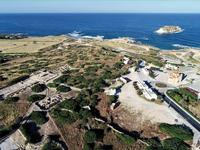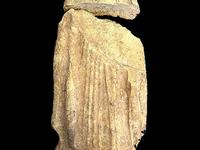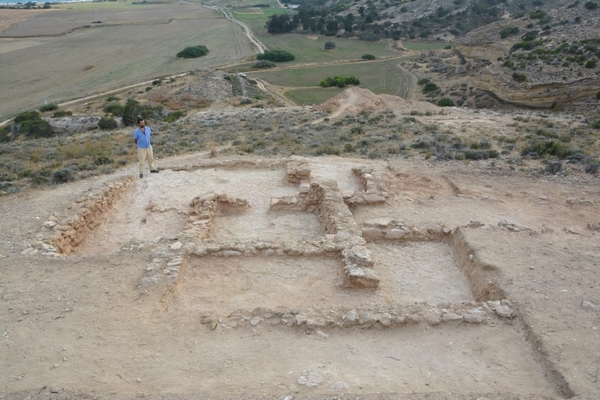Press Releases
05-09-2023 12:28
Excavations at Pyla-Kokkinokremos site
The Department of Antiquities of the Deputy Ministry of Culture announces the completion of the one-month excavation of 2023 at Pyla-Kokkinokremos from March 30th to April 28th. The excavation was conducted under the direction of Prof Joachim Bretschneider from Ghent University, in close collaboration with Prof. Sorin Hermon from The Cyprus Institute, Dr. Reinhard Jung from the Austrian Academy of Science and Prof. Lina Kassianidou from the University of Cyprus.
The excavation focused its efforts on the eastern lobe of the summit plateau, specifically focusing on Sector 5, the trench along the east side, and simultaneously, on Sector 7, situated on the opposite western slope of the same lobe.
Sector 5
The primary objective of Sector 5 excavation was to further investigate Spaces 5.48 and 5.49, which were partially exposed during the 2021 campaign. The goal was to define their boundaries, as well as the adjacent areas to the north and south (Fig. 2). Upon excavation of Space 5.49, the contours of a well-cut shaft became evident. This roughly square shaft, approximately 3 meters deep, occupies a significant portion of the room. It yielded a few copper alloy pieces and a fragment of a stone basin or trough. Notably, man-made cavities were observed in the opposite walls of the shaft, suggesting their potential use as steps or for securing wooden beams.
To the north of Space 5.49, two distinct yet interconnected spaces, Spaces 5.51 and Space 5.52, were identified and examined. In both rooms pithos sherds were found. Additionally, two fragmented Base Ring II juglets and a bronze object, possibly a broken bracelet, were unearthed in Space 5.52.
During previous excavation campaigns, Space 5.48, situated south of Space 5.49, had been partially excavated. In the 2023 season, the excavation efforts resumed, leading to the discovery of the western section and wall of this space. Its floor yielded a substantial amount of pottery, including a lid, a large amount of pithos sherds, a small pithos/jar, a shallow stemmed bowl, part of a sieve spouted vessel, a Canaanite jar, fragments of a stone basin, two potential stone tools, and an alabaster rim. A dark grey discoloration interpreted as a hearth was found in the centre of the room. Based on preliminary analysis, this space is believed to be a courtyard with multiple entrances.
Moving southward to Space 5.39B, excavations in this area revealed pithos fragments, and possibly fine ware sherds. There are potential entrances leading north to Space 5.48 and west to a small room, Space 5.53. Within the latter, two fragmented Canaanite jars were collected.
Sector 7.1
The 2023 excavations, revealed Canaanite jar sherds, a terracotta spindle whorl, and a possible whetstone or anvil were unearthed. Moreover, the existence of an entrance between Space 7.1.1 and Space 7.1.3 was confirmed. It is suggested that Space 7.1.3 likely served as a corridor, given its narrow, elongated shape. The eastern part of Space 7.1.3 revealed a small niche where three semi-complete vessels – a Canaanite jar, a Plain Ware pithos and a Cypriot Plane Ware jug – were discovered, indicating storage capability.
Space 7.1.1 is also connected to the smaller Space 7.1.2 to the east. There, several artefacts were found, including a small vessel, a stone pestle, a fragmentary spindle whorl, and a well-preserved copper alloy axe (Fig. 5). To the north of Space 7.1.2, we encountered another narrow elongated space, Space 7.1.4. Its floor is situated at a higher level compared to Spaces 7.1.1-7.1.3. Excavation revealed sherds of a painted Mycenaean amphoroid crater decorated with a band of deer (Fig. 4), cooking ware, a Canaanite jar, copper alloy wire fragments and a stone loom weight.
Sector 7.2
Lower down the slope of Sector 7.1, remains of another structure were excavated. Surface cleaning during the 2019 campaign had revealed the outline of a structure of ca. 6 m north-south by 8 m east-west, located near the slope, where we assume the access to the harbour was located. This structure comprised three parallel rectangular spaces, numbered 7.2.1 to 7.2.3, of which the most western, lowest Space 7.2.1, was excavated (Fig. 6). The room features two doorways and contained sherds of a cooking pot and a fine small stirrup jar and a terracotta spindle whorl. The most surprising fact encountered was the presence of a sandy fill, which appeared very much as beach sand. Similar sandy fills had already been found in Sector 5 and Sector 7.1 but it does not occur elsewhere on the site.

Fig.1: Sector 7.1 – Spaces 7.1.5 and 7.1.6 in the foreground and behind Spaces 7.1.1 and 7.1.2

Fig. 2: Sector 7.1, Space 7.1.4 – Mycenaean amphoroid crater decorated with a band of deer.
(MV/ECHR)
Relevant Press Releases



22-11-2024 11:25
The “Royal Chapel” of Agia Aikaterini at Pyrga closed for the public






